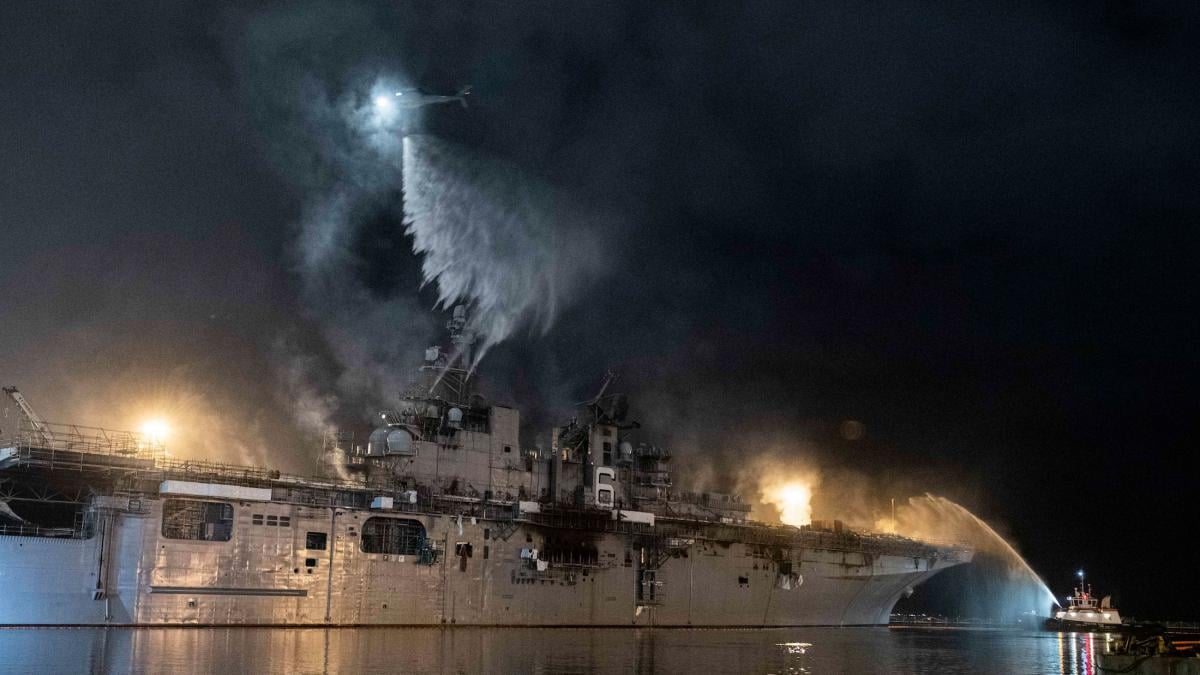By Commander James Leineweber
 The July fire on board the USS Bonhomme Richard (LHD-6) offers the Navy and the nation’s shipyards a valuable opportunity they have not had the since the end of World War II—the chance to repair a capital ship that has suffered catastrophic damage. As USNI News notes: “Between December 1941 and September 1945, over 350 U.S. Navy warships and patrol craft were sunk or damaged beyond repair. In the nearly seven decades since, fewer than 30 ships have been lost directly due to enemy action or accidents.”
The July fire on board the USS Bonhomme Richard (LHD-6) offers the Navy and the nation’s shipyards a valuable opportunity they have not had the since the end of World War II—the chance to repair a capital ship that has suffered catastrophic damage. As USNI News notes: “Between December 1941 and September 1945, over 350 U.S. Navy warships and patrol craft were sunk or damaged beyond repair. In the nearly seven decades since, fewer than 30 ships have been lost directly due to enemy action or accidents.”
The cost to repair the Bonhomme Richard will be high, coming on the back of its $249 million maintenance availability—perhaps even greater than the $3 billion dollar price tag to replace her with a new America-class LHA. There are many advocates making logical arguments that the extensive damage requires the Bonhomme Richard be decommissioned and struck from the Naval Vessel Register. Indeed, Chief of Naval Operations Admiral Mike Gilday has asked, “Should we make that investment in a 22-year-old ship? . . . I’m not going to make any predictions until we take a look at all the facts and we follow the facts and we can make reasonable recommendations up the chain of command on the future steps, any repair efforts, future repair efforts of Bonhomme Richard.” However, even in the current fiscal environment the Navy needs to look beyond the dollar cost as it decides the fate of the Bonhomme Richard.
If the United States goes to war with a peer adversary, some warships will suffer severe combat damage. Consider that it took nearly two years to repair the USS John S. McCain (DDG-56) and USS Fitzgerald (DDG-62) following their 2017 collisions. In a fight with China for control of the Pacific, the United States will not have that long to get ships back in the fight. Taking years for repairs could cause the United States to lose the next war not long after the first major naval engagement. As unfortunate as the Bonhomme Richard fire was, the Navy now has an opportunity to relearn repairing severely damaged ships and getting them back into the fight.
“Damage to the amphibious assault ship USS Bonhomme Richard caused by fires, explosions, and flooding is ‘extensive,” Gilday said in a summary report. “. . .We have not seen a fire of this magnitude on a Navy ship in recent memory, at least in my career.” Sailors and civilian contractors now will be able to develop and capture best practices on repairing catastrophically damaged ships. There will be setbacks—some ideas on how to best repair the ship will not work out, and costs will exceed original estimates, all while well-intentioned civilian bureaucrats and politicians question the Navy’s decision to repair rather than replace the ship. The Navy can overcome the setbacks and minimize the cost overruns while reinforcing a message that this is not just about repairing a damaged ship, it is about relearning the lost art of repairing battle-damaged ships. The nation that masters this first will have an advantage over its adversaries.
Repairing the Bonhomme Richard also will afford the Navy the chance to learn about the ship after it has been returned to service. For this reason, the Navy would be wise to embed civilian representatives from commercial shipyards, Naval Sea Systems Command, and any other commands that can learn from the Bonhomme Richard’s crew at sea following extensive repairs. Even in an ideal world after an extensive yard period, a ship’s systems will not always work as designed. The Bonhomme Richard will likely have numerous issues to resolve after being repaired.
Rather than thinking of the Bonhomme Richard as a badly damaged warship in need of scrapping or repair, she should be thought of as a floating test bed, laboratory, and schoolhouse in how to repair a badly damaged modern warship. Imagine if the Navy had possessed the institutional knowledge in ship repair on 7 December 1941 that it had on 2 September 1945. Having a robust ship-building industrial base ready for the demands of naval warfare is not just about being able to build new ships, it is also about being able to repair ships after they have been damaged in battle. It would be a tremendous mistake to miss this once-in-a-generation opportunity to learn how to do so.
No comments:
Post a Comment